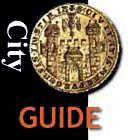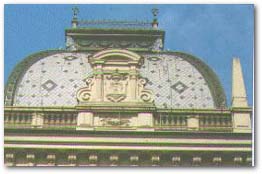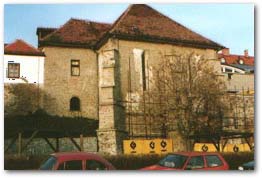

![]() Although Maribor as
a town goes back to medieval times, very little of its
medieval architecture remains - in most cases just the
foundations of buildings in the very heart of the city
centre. On such remains either new buildings were
erected, or old buildings totally renovated, so that
their original appearance was lost. On the other hand,
the basic layout of the town was retained: that is, the
funnel-shaped configuration from the Castle to the Glavni trg
(Main Square), where the streets from the north led, and
the Koroska cesta, (Carinthian Road), which led to the
western town gate.
Although Maribor as
a town goes back to medieval times, very little of its
medieval architecture remains - in most cases just the
foundations of buildings in the very heart of the city
centre. On such remains either new buildings were
erected, or old buildings totally renovated, so that
their original appearance was lost. On the other hand,
the basic layout of the town was retained: that is, the
funnel-shaped configuration from the Castle to the Glavni trg
(Main Square), where the streets from the north led, and
the Koroska cesta, (Carinthian Road), which led to the
western town gate.

![]() The oldest
architectural treasure in Maribor is the Catholic Church of St. John the Baptist, first mentioned in
1248. Over the centuries, it adapted elements from
several architectural styles and was successful in
melding them into a harmonious whole.
The oldest
architectural treasure in Maribor is the Catholic Church of St. John the Baptist, first mentioned in
1248. Over the centuries, it adapted elements from
several architectural styles and was successful in
melding them into a harmonious whole.
![]() The next important Maribor architectural monument
is the Castle, built towards the end of the fifteenth
century. Over the centuries it evolved from a
fortification into a nobleman's castle; finally, it
became an ethnographic museum. The Castle, too,
shows a number of different arhitectural styles: from the
Gothic, to the Renaissance and to the Rococo.
The next important Maribor architectural monument
is the Castle, built towards the end of the fifteenth
century. Over the centuries it evolved from a
fortification into a nobleman's castle; finally, it
became an ethnographic museum. The Castle, too,
shows a number of different arhitectural styles: from the
Gothic, to the Renaissance and to the Rococo.
 On
the other hand, the Town Hall in the Glavni trg (Main Square) is a Renaissance
masterpiece. The most medieval architectural remains are
what is left of the Jewish quarter east of the Glavni
trg (Main Square). The quarter was once part
of the town wall, along with the synagogue
and two towers on the left bank of the Drava river (Water Tower and Round Tower).
On
the other hand, the Town Hall in the Glavni trg (Main Square) is a Renaissance
masterpiece. The most medieval architectural remains are
what is left of the Jewish quarter east of the Glavni
trg (Main Square). The quarter was once part
of the town wall, along with the synagogue
and two towers on the left bank of the Drava river (Water Tower and Round Tower).
![]() The old inner city still shows the characteristic
features of the Baroque in some of the manor
houses. The renovation of the houses in town, on the
other hand, has singulary distorted their Baroque
features.
The old inner city still shows the characteristic
features of the Baroque in some of the manor
houses. The renovation of the houses in town, on the
other hand, has singulary distorted their Baroque
features.

![]() The nineteenth
century was the architectural Golden Age for Maribor.
Here we have examples of the rather pompous architecture
of the Austrian monarchy, for example, the Post office,
the City savings bank, the Court building,
and the classical secondary school (Gymnasium)
building.
The nineteenth
century was the architectural Golden Age for Maribor.
Here we have examples of the rather pompous architecture
of the Austrian monarchy, for example, the Post office,
the City savings bank, the Court building,
and the classical secondary school (Gymnasium)
building.